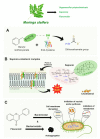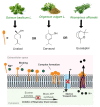Green and Healthier Alternatives to Chemical Additives as Cheese Preservative: Natural Antimicrobials in Active Nanopackaging/Coatings
- PMID: 34451212
- PMCID: PMC8398146
- DOI: 10.3390/polym13162675
Green and Healthier Alternatives to Chemical Additives as Cheese Preservative: Natural Antimicrobials in Active Nanopackaging/Coatings
Abstract
The side effects and potential impacts on human health by traditional chemical additives as food preservatives (i.e., potassium and sodium salts) are the reasons why novel policies are encouraged by worldwide public health institutes. More natural alternatives with high antimicrobial efficacy to extend shelf life without impairing the cheese physicochemical and sensory quality are encouraged. This study is a comprehensive review of emerging preservative cheese methods, including natural antimicrobials (e.g., vegetable, animal, and protist kingdom origins) as a preservative to reduce microbial cheese contamination and to extend shelf life by several efforts such as manufacturing ingredients, the active ingredient for coating/packaging, and the combination of packaging materials or processing technologies. Essential oils (EO) or plant extracts rich in phenolic and terpenes, combined with packaging conditions and non-thermal methods, generally showed a robust microbial inhibition and prolonged shelf life. However, it impaired the cheese sensory quality. Alternatives including EO, polysaccharides, polypeptides, and enzymes as active ingredients/nano-antimicrobials for an edible film of coating/nano-bio packaging showed a potent and broad-spectrum antimicrobial action during shelf life, preserving cheese quality parameters such as pH, texture, color, and flavor. Future opportunities were identified in order to investigate the toxicological effects of the discussed natural antimicrobials' potential as cheese preservatives.
Keywords: antimicrobial coatings; biobased materials; biopackaging materials; biopolymers; cheese shelf-life; edible coatings; edible films; nano-antimicrobials; polyphenols; polysaccharides.
Conflict of interest statement
The authors have no competing interests to disclose.
Figures




Similar articles
-
Antimicrobial effectiveness of bioactive packaging materials from edible chitosan and casein polymers: assessment on carrot, cheese, and salami.J Food Sci. 2011 Jan-Feb;76(1):M54-63. doi: 10.1111/j.1750-3841.2010.01910.x. Epub 2010 Nov 29. J Food Sci. 2011. PMID: 21535694
-
Application of Plant Oils as Functional Additives in Edible Films and Coatings for Food Packaging: A Review.Foods. 2024 Mar 25;13(7):997. doi: 10.3390/foods13070997. Foods. 2024. PMID: 38611303 Free PMC article. Review.
-
Effect of liquid whey protein concentrate-based edible coating enriched with cinnamon carbon dioxide extract on the quality and shelf life of Eastern European curd cheese.J Dairy Sci. 2021 Feb;104(2):1504-1517. doi: 10.3168/jds.2020-18732. Epub 2020 Dec 11. J Dairy Sci. 2021. PMID: 33309377
-
Application of edible coating with essential oil in food preservation.Crit Rev Food Sci Nutr. 2019;59(15):2467-2480. doi: 10.1080/10408398.2018.1456402. Epub 2018 Dec 30. Crit Rev Food Sci Nutr. 2019. PMID: 29580066 Review.
-
Use of edible films and coatings in cheese preservation: Opportunities and challenges.Food Res Int. 2018 May;107:84-92. doi: 10.1016/j.foodres.2018.02.013. Epub 2018 Feb 4. Food Res Int. 2018. PMID: 29580546 Review.
Cited by
-
Fungistatic Effect of Phthalide Lactones on Rhodotorula mucilaginosa.Molecules. 2023 Jul 15;28(14):5423. doi: 10.3390/molecules28145423. Molecules. 2023. PMID: 37513295 Free PMC article.
-
Strategies and Challenges for Successful Implementation of Green Economy Concept: Edible Materials for Meat Products Packaging.Foods. 2021 Dec 7;10(12):3035. doi: 10.3390/foods10123035. Foods. 2021. PMID: 34945586 Free PMC article.
-
Antimicrobial Active Packaging Containing Nisin for Preservation of Products of Animal Origin: An Overview.Foods. 2022 Nov 26;11(23):3820. doi: 10.3390/foods11233820. Foods. 2022. PMID: 36496629 Free PMC article. Review.
-
A Series of Green Oxovanadium(IV) Precatalysts with O, N and S Donor Ligands in a Sustainable Olefins Oligomerization Process.Molecules. 2022 Nov 19;27(22):8038. doi: 10.3390/molecules27228038. Molecules. 2022. PMID: 36432140 Free PMC article.
-
Caraway Essential Oil as a Post-Preservative Agent in Low-Salt Cheese Brine.Foods. 2025 Apr 8;14(8):1297. doi: 10.3390/foods14081297. Foods. 2025. PMID: 40282698 Free PMC article.
References
-
- Dairy Industries International Global Cheese Markets Hit Record Highs. [(accessed on 12 March 2021)]; Available online: https://www.dairyindustries.com/news/35273/global-cheese-markets-hit-rec...
Publication types
Grants and funding
- E-26/2543334/2019/Fundação Carlos Chagas Filho de Amparo à Pesquisa do Estado do Rio de Janeiro
- 26/010.000.984/2019/Fundação Carlos Chagas Filho de Amparo à Pesquisa do Estado do Rio de Janeiro
- E-26/010.000148/2020/Fundação Carlos Chagas Filho de Amparo à Pesquisa do Estado do Rio de Janeiro
- E-26/200.722/2021/Fundação Carlos Chagas Filho de Amparo à Pesquisa do Estado do Rio de Janeiro
- 311422/2016-0/Conselho Nacional de Desenvolvimento Científico e Tecnológico
LinkOut - more resources
Full Text Sources

